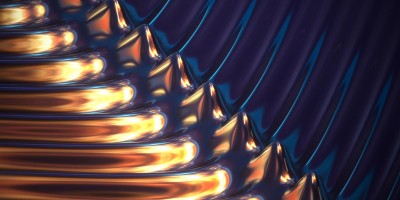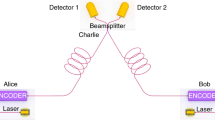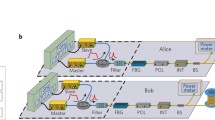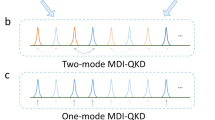Abstract
Quantum key distribution (QKD) can provide fundamentally proven secure communication. Towards application, the secret key rate (SKR) is a key figure of merit for any QKD system. The SKR has so far been limited to about a few megabits per second. Here we report a QKD system that is able to generate keys at a record high SKR of 115.8 Mb s–1 over a 10 km standard optical fibre, and distribute keys over up to 328 km of ultralow-loss fibre. Such abilities are attributed to a multipixel superconducting nanowire single-photon detector with an ultrahigh counting rate, an integrated transmitter that can stably encode polarization states with low error, a fast post-processing algorithm for generating keys in real time and the high system clock rate operation. The results demonstrate the feasibility of practical high-rate QKD with photonic techniques, thus opening its possibility for widespread applications.




Similar content being viewed by others
Data availability
All of the data that support the findings of this study are reported in the main text and Supplementary Information. Source data are available from the corresponding authors on reasonable request.
References
Bennett, C. H. & Brassard, G. Quantum cryptography: public key distribution and coin tossing. In Proc. IEEE International Conference on Computers, Systems and Signal Processing 175–179 (IEEE, 1984).
Ekert, A. K. Quantum cryptography based on Bell’s theorem. Phys. Rev. Lett. 67, 661 (1991).
Xu, F., Ma, X., Zhang, Q., Lo, H.-K. & Pan, J.-W. Secure quantum key distribution with realistic devices. Rev. Mod. Phys. 92, 025002 (2020).
Chen, Y.-A. et al. An integrated space-to-ground quantum communication network over 4,600 kilometres. Nature 589, 214–219 (2021).
Diamanti, E., Lo, H.-K., Qi, B. & Yuan, Z. Practical challenges in quantum key distribution. NPJ Quantum Inf. 2, 16025 (2016).
Sasaki, M. Quantum networks: where should we be heading? Quantum Sci. Technol. 2, 020501 (2017).
Takesue, H. et al. Quantum key distribution over a 40-dB channel loss using superconducting single-photon detectors. Nat. Photon. 1, 343–348 (2007).
Lucamarini, M. et al. Efficient decoy-state quantum key distribution with quantified security. Opt. Express 21, 24550–24565 (2013).
Yuan, Z. et al. 10-Mb/s quantum key distribution. J. Light. Technol. 36, 3427–3433 (2018).
Islam, N. T., Lim, C. C. W., Cahall, C., Kim, J. & Gauthier, D. J. Provably secure and high-rate quantum key distribution with time-bin qudits. Sci. Adv. 3, e1701491 (2017).
Boaron, A. et al. Secure quantum key distribution over 421 km of optical fiber. Phys. Rev. Lett. 121, 190502 (2018).
Grünenfelder, F., Boaron, A., Rusca, D., Martin, A. & Zbinden, H. Performance and security of 5 GHz repetition rate polarization-based quantum key distribution. Appl. Phys. Lett. 117, 144003 (2020).
Agnesi, C. et al. Simple quantum key distribution with qubit-based synchronization and a self-compensating polarization encoder. Optica 7, 284–290 (2020).
Lucamarini, M., Yuan, Z. L., Dynes, J. F. & Shields, A. J. Overcoming the rate–distance limit of quantum key distribution without quantum repeaters. Nature 557, 400–403 (2018).
Tomamichel, M., Lim, C. C. W., Gisin, N. & Renner, R. Tight finite-key analysis for quantum cryptography. Nat. Commun. 3, 634 (2012).
Lim, C. C. W., Curty, M., Walenta, N., Xu, F. & Zbinden, H. Concise security bounds for practical decoy-state quantum key distribution. Phys. Rev. A 89, 022307 (2014).
Rusca, D., Boaron, A., Grünenfelder, F., Martin, A. & Zbinden, H. Finite-key analysis for the 1-decoy state QKD protocol. Appl. Phys. Lett. 112, 171104 (2018).
Tanaka, A. et al. High-speed quantum key distribution system for 1-Mbps real-time key generation. IEEE J. Quantum Electron. 48, 542–550 (2012).
Fröhlich, B. et al. Long-distance quantum key distribution secure against coherent attacks. Optica 4, 163–167 (2017).
Wang, X.-B. Beating the photon-number-splitting attack in practical quantum cryptography. Phys. Rev. Lett. 94, 230503 (2005).
Lo, H.-K., Ma, X. & Chen, K. Decoy state quantum key distribution. Phys. Rev. Lett. 94, 230504 (2005).
Hadfield, R. H. Single-photon detectors for optical quantum information applications. Nat. Photon. 3, 696–705 (2009).
Marsili, F. et al. Detecting single infrared photons with 93% system efficiency. Nat. Photon. 7, 210–214 (2013).
You, L. Superconducting nanowire single-photon detectors for quantum information. Nanophotonics 9, 2673–2692 (2020).
Korzh, B. et al. Provably secure and practical quantum key distribution over 307 km of optical fibre. Nat. Photon. 9, 163–168 (2015).
Comandar, L. C. et al. Quantum key distribution without detector vulnerabilities using optically seeded lasers. Nat. Photon. 10, 312–315 (2016).
Zhang, W. et al. A 16-pixel interleaved superconducting nanowire single-photon detector array with a maximum count rate exceeding 1.5 GHz. IEEE Trans. Appl. Supercond. 29, 2200204 (2019).
Mao, H.-K., Li, Q., Hao, P.-L., Abd-El-Atty, B. & Iliyasu, A. M. High performance reconciliation for practical quantum key distribution systems. Opt. Quantum Electron. 54, 163 (2022).
Yan, B., Li, Q., Mao, H. & Chen, N. An efficient hybrid hash based privacy amplification algorithm for quantum key distribution. Quantum Inf. Process. 21, 130 (2022).
Yuan, Z. et al. Robust random number generation using steady-state emission of gain-switched laser diodes. Appl. Phys. Lett. 104, 261112 (2014).
Ma, C. et al. Silicon photonic transmitter for polarization-encoded quantum key distribution. Optica 3, 1274–1278 (2016).
Sibson, P. et al. Integrated silicon photonics for high-speed quantum key distribution. Optica 4, 172–177 (2017).
Wei, K. et al. High-speed measurement-device-independent quantum key distribution with integrated silicon photonics. Phys. Rev. X 10, 031030 (2020).
Avesani, M. et al. Full daylight quantum-key-distribution at 1550 nm enabled by integrated silicon photonics. NPJ Quantum Inf. 7, 93 (2021).
Xavier, G., de Faria, G. V., Temporão, G. & Von der Weid, J. Full polarization control for fiber optical quantum communication systems using polarization encoding. Opt. Express 16, 1867–1873 (2008).
Vorontsov, M. A., Carhart, G. W. & Ricklin, J. C. Adaptive phase-distortion correction based on parallel gradient-descent optimization. Opt. Lett. 22, 907–909 (1997).
Dauler, E. A. et al. Photon-number-resolution with sub-30-ps timing using multi-element superconducting nanowire single photon detectors. J. Mod. Opt. 56, 364–373 (2009).
Scarani, V. & Renner, R. Quantum cryptography with finite resources: unconditional security bound for discrete-variable protocols with one-way postprocessing. Phys. Rev. Lett. 100, 200501 (2008).
Lee, C. et al. Large-alphabet encoding for higher-rate quantum key distribution. Opt. Express 27, 17539–17549 (2019).
Wang, H. et al. High-speed gaussian-modulated continuous-variable quantum key distribution with a local local oscillator based on pilot-tone-assisted phase compensation. Opt. Express 28, 32882–32893 (2020).
Qi, B., Lougovski, P., Pooser, R., Grice, W. & Bobrek, M. Generating the local oscillator ‘locally’ in continuous-variable quantum key distribution based on coherent detection. Phys. Rev. X 5, 041009 (2015).
Cañas, G. et al. High-dimensional decoy-state quantum key distribution over multicore telecommunication fibers. Phys. Rev. A 96, 022317 (2017).
Wengerowsky, S., Joshi, S. K., Steinlechner, F., Hübel, H. & Ursin, R. An entanglement-based wavelength-multiplexed quantum communication network. Nature 564, 225–228 (2018).
Bacco, D. et al. Boosting the secret key rate in a shared quantum and classical fibre communication system. Commun. Phys. 2, 140 (2019).
Wang, H. et al. Sub-Gbps key rate four-state continuous-variable quantum key distribution within metropolitan area. Commun. Phys. 5, 162 (2022).
Roumestan, F. et al. High-rate continuous variable quantum key distribution based on probabilistically shaped 64 and 256-QAM. In 2021 European Conference on Optical Communication (ECOC) 1–4 (IEEE, 2021).
Fröhlich, B. et al. A quantum access network. Nature 501, 69–72 (2013).
Wang, J., Sciarrino, F., Laing, A. & Thompson, M. G. Integrated photonic quantum technologies. Nat. Photon. 14, 273–284 (2020).
Acknowledgements
We would like to thank B. Bai, Y. Hong, X. Jiang, Z. Yuan, W.-J. Zhang and J. Zhang for helpful discussions and assistance. This work was supported by National Natural Science Foundation of China (grant no. 62031024, 62071151), Innovation Program for Quantum Science and Technology (grant no. 2021ZD0300300), Shanghai Municipal Science and Technology Major Project (grant no. 2019SHZDZX01), Shanghai Science and Technology Development Funds (grant no. 22JC1402900), Shanghai Academic/Technology Research Leader (grant no. 21XD1403800), Key-Area Research and Development Program of Guangdong Province (grant no. 2020B0303020001), Anhui Initiative in Quantum Information Technologies and Chinese Academy of Sciences. W.L. acknowledges support from the Natural Science Foundation of Shanghai (grant no. 22ZR1468100). F.X. acknowledges the support from the Tencent Foundation.
Author information
Authors and Affiliations
Contributions
F.X. and J.-W.P. conceived the research and designed the experiments. W.L., L.Z. and F.X. performed the experiments. W.L., L.Z., H.T., Y.L. and F.X. analysed the data. W.L., S.-K.L., C.-Z.P. and F.X. developed the photonic chip. H.-K.M., B.Y. and Q.L. implemented the post-processing algorithms. J.H., H.L., Z.W. and L.Y. developed the SNSPDs, with input from Y.L. and Q.Z. W.L., F.X. and J.-W.P. wrote the manuscript, with input from all authors. All authors contributed materials and analysis tools.
Corresponding authors
Ethics declarations
Competing interests
The authors declare no competing interests.
Peer review
Peer review information
Nature Photonics thanks the anonymous reviewers for their contribution to the peer review of this work.
Additional information
Publisher’s note Springer Nature remains neutral with regard to jurisdictional claims in published maps and institutional affiliations.
Supplementary information
Rights and permissions
Springer Nature or its licensor (e.g. a society or other partner) holds exclusive rights to this article under a publishing agreement with the author(s) or other rightsholder(s); author self-archiving of the accepted manuscript version of this article is solely governed by the terms of such publishing agreement and applicable law.
About this article
Cite this article
Li, W., Zhang, L., Tan, H. et al. High-rate quantum key distribution exceeding 110 Mb s–1. Nat. Photon. 17, 416–421 (2023). https://doi.org/10.1038/s41566-023-01166-4
Received:
Accepted:
Published:
Issue Date:
DOI: https://doi.org/10.1038/s41566-023-01166-4
- Springer Nature Limited
This article is cited by
-
Self-supervised dynamic learning for long-term high-fidelity image transmission through unstabilized diffusive media
Nature Communications (2024)
-
Real-time polarization compensation method in quantum communication based on channel Muller parameters detection
Communications Engineering (2024)
-
Improved security bounds against the Trojan-horse attack in decoy-state quantum key distribution
Quantum Information Processing (2024)
-
High secret key rate goes a long way
Nature Photonics (2023)
-
A superconducting nanowire single-photon camera with 400,000 pixels
Nature (2023)





